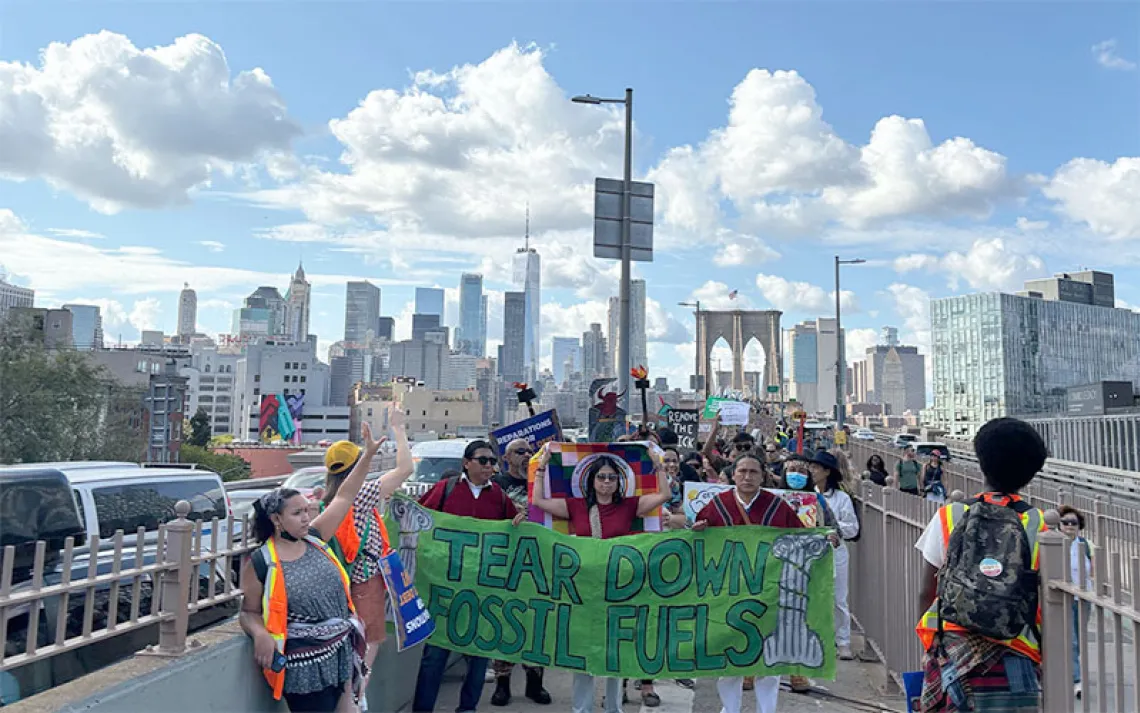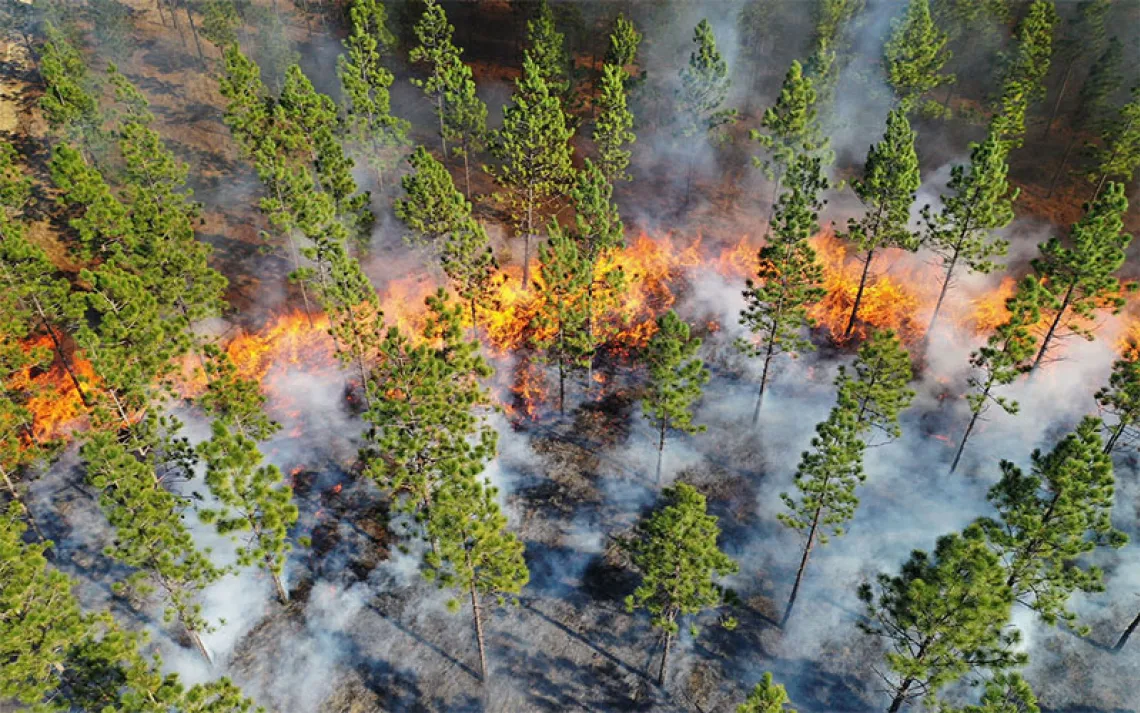#SchoolStrike4Climate Is Coming to a City Near You
Kids across the United States join Europe in schooling adults on climate change

Isra Hirsi, one of the lead US organizers for #SchoolStrikeforClimate | Photo Courtesy of Isra Hirsi
On a chilly February day in New York City, about a dozen elementary, middle, and high school students gather around a PowerPoint presentation in a generic conference room. It could be a weekly meeting of any school club or an attempt to collaborate on an academic project. But these students are here to make plans to shut down schools across the country in conjunction with a global climate strike that will take place on Friday, March 15.
Thirteen-year-old climate activist Alexandria Villaseñor leads the meeting. “I’m working on getting… a Canadian rapper for climate change. He’s kind of my mom’s generation actually,” she announces to a roomful of laughter. “After the march, we’ll get him capturing people’s attention.”
Over the course of about an hour, the students make introductions, share their favorite foods and dream jobs, giggle through some awkward silence. They cover a lot of ground. “We’re working on getting a new national logo,” explains 15-year-old activist Isra Hirsi, who has phoned in to the meeting from Minneapolis. “After that, we’re going to work on getting shirts, to fundraise for the D.C. rally, do outreach, and connect with as many states as possible. I think right now we have about 20 or 30 states.”
Villaseñor and Hirsi are part of a three-person power team co-leading the first United States–wide #SchoolStrike4Climate, as the hashtag has come to define it, a movement inspired by 16-year-old climate activist Greta Thunberg, who has been on strike outside of the Swedish parliament building every Friday since September. Thunberg’s action has mobilized tens of thousands of students throughout Europe and Australia to skip school to demand action on the “climate breakdown.” Smaller groups and individual students have joined in solidarity from as far and wide as Thailand, Colombia, and Uganda.
In the US, the movement has yet to take hold on a large scale. Villaseñor, Hirsi, and their third partner, Haven Coleman, of Denver, Colorado, are hoping to change that. Coleman, who will be 13 in March, has bundled up each Friday since January 4 and sat outside high-traffic areas like the Colorado State Capitol building with a sign similar to others around the world, reading “School Strike For Climate.” Unlike in Europe, where students have shown up in droves, blocked traffic, and taken over whole squares, Coleman’s regular Friday strike is a solitary one. It’s “people pretty much herding their kids away [from me],” she says. “Once they’re like ‘OK, there’s a kid sitting outside of this building’ and they read my signs, I think it sort of gets them thinking. But most of them walk by, look at me, and give me weird glances.”
Villaseñor’s strikes have followed a similar, solitary rhythm. She has set up outside the United Nations building in New York every Friday for the past 10 weeks, including during the recent “arctic blast.” Some of the people who pass by the spot that her Twitter followers have geotagged as “Alexandria’s bench” have stopped to ask questions, but until this past Friday (when five other kids showed up), no one had joined her. “I don’t take offense,” she says. “New York City is a very fast-paced city. Everyone has their own schedules.”

Haven Coleman has been going on strike each Friday since January 4. | Photo by Nicole Coleman
In addition to demanding that leaders commit to limiting global temperature rise to 1.5°C above pre industrial temperatures, aligning with the United Nations’ Paris Agreement, and passing a Green New Deal in the US, the small but growing band of youth activists who regularly strike in the US are also advocating for schools to adopt curricula that addresses climate breakdown. Currently, Villaseñor explains, climate change doesn’t get much air time. “They don’t teach you the real honest truth because, I don’t know . . . maybe they think kids can’t handle it?” Coleman agrees. She stumbled upon the concept when she was doing research on deforestation, which she worried about impacting her favorite animal, the sloth. “I went down a bunny hole figuring out what climate change was,” she says. She quickly realized the gravity of the situation. “This is going to be affecting us our whole lives. It is going to be our generation’s problem, and if we don’t push the people in power—they’re not going to be alive, so they don’t really care what happens—they’re gonna give us this messed-up world.”
Coleman got in touch with Hirsi only a few weeks ago, after hearing about her effort to try and get newly elected Minnesota governor Tim Walz to stop an Alberta-based oil company from building a pipeline through northern Minnesota's Indigenous lands. Hirsi says that previously, she was more focused on social issues, like racial inequality and immigration, but when Coleman contacted her, she quickly recognized the intersectional potential of the school strike movement. “When you talk about the Green New Deal and things like the Minnesota Green New Deal, then people realize that it’s not just a white thing,” she says. “If we talk about how [climate change] affects everybody— especially people of color—I think we could completely change the narrative.”
Although Coleman, Hirsi, and Villaseñor have never met in person, for the past few weeks, they have spent what Coleman and Hirsi estimate as six to eight hours per day, or about 42 hours per week, on the phone, sending emails, texts, and tweets. The trio has decided to keep the nationwide climate strike movement independent of established organizations. But they are tapping into the environmental and social justice groups that they are each already involved with.
Coleman and Villaseñor both work with their local chapters of Zero Hour, the youth-led climate action movement founded by Jamie Margolin—who Coleman refers to affectionately as her “big sister”—and other leaders of color that led a three-day global climate mobilization in July 2018. Coleman is also involved with youth-led activist group Sunrise Movement, which has gained the support of freshman congresswoman Alexandria Ocasio-Cortez in campaigning for the Green New Deal. According to Sunrise's communications director, Stephen O’Hanlon, Sunrise members across the country are planning to join the climate strikes on March 15. Villaseñor and Coleman have also been in touch with chapters of organizations like Extinction Rebellion, 360, and the Sierra Club.

Alexandra Villaseñor outside the United Nations | Photo courtesy of Alexandra Villaseñor
“Haven and Alexandria have more of the contacts when it comes to organizations,” Hirsi explains. “Both of them are in charge of mapping it out and outreach.” Hirsi herself is not new to organizing, having led three school walkouts of about 100 students each to raise awareness around gun control. She’s also helped to orchestrate a handful of state-wide rallies on a variety of issues, so she’s in charge of directing the head organizers of each state. “And, I run the email and Twitter accounts,” she adds.
Hirsi sees her role, which is in many ways that of a full-time communications director, as an opportunity. Getting people involved has a lot to do with “the way in which we do our messaging,” Hirsi says. Many communities of color “don’t feel that [climate change] affects them. . . . People that look like me,” she says, “we think of climate change and think of trees dying . . . you don’t think ‘Oh, I’m not going to have clean water.’” To make striking more accessible to communities that have not had the opportunity to spend much time in the outdoors, or become educated about climate issues or activism, Hirsi says that marches will be held not just in city centers or outside government buildings but also on school grounds, so everybody can participate.
In addition to not sleeping, being on the phone at odd hours with youth activists across the world, getting attacked on social media by climate change deniers, messaged by creepy men, and scolded for falling behind in school, the trio is essentially trying to develop a “strike-friendly” culture in a matter of mere weeks, which might be the greatest challenge of all. “In Europe, [students] can just go out in the streets every Friday; they have that spontaneity,” Villaseñor says. “But in America, we have to have everything structured, so it’s harder to get Americans mobilized for climate action.”
Climate scientists who have devoted careers to raising awareness around climate change, like Dr. Genevieve Guenther and Dr. Michael Mann, are cautiously optimistic that youth climate activism is, what Mann refers to as a “game-changer.” Mann notes that the weekly demonstrations and upcoming nationwide strike have the potential to push the US to a tipping point of public consciousness. “The school strike brings the movement for climate action home,” says Guenther. “When children explain to their parents why they’re rising up, they might shake their parents out of their complacency, inspiring them to rise up themselves on behalf of the children they claim to love more than anything.”
At the organizing meeting in New York, students make plans to ask scientists and academics to write a letter of support for young people choosing to strike in the US, as 224 academics in the UK, and 3,400 scientists in Belgium have done. For the New York City strike, they discuss permits and the need to contact the NYPD. They also work on plans to contact the heads of environmental organizations at schools in each borough.
One student attending the meeting asks Villaseñor if students in New Jersey should strike in their state or join the New York City strike. “In the end, people are going to do what they want; they will call it what they want; they will strike, march, rally wherever they want. The only thing [we] can do is support them,” Villaseñor says. “The whole point,” Hirsi notes, “is to be like, "This is what you can do. This is how you can do it. We can all come together and fight for one single issue.”
 The Magazine of The Sierra Club
The Magazine of The Sierra Club



